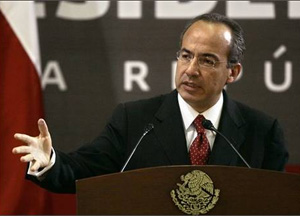 |
 |
 |
 Editorials | March 2007 Editorials | March 2007  
The Cartel Responds to Calderon
 Stratfor.com Stratfor.com


| | Religious leaders said Wednesday they have formed a united front against bills to legalize abortion in Mexico, an issue that has divided the nation and drawn in conservative President Felipe Calderon. (AP) |
The cartels' tendencies to fight back and shift their operations will continue to manifest themselves as Calderon's anti-drug efforts proceed.

Summary

Mexican President Felipe Calderon sent federal troops into the southern state of Tabasco on March 17, opening up the latest front in a crackdown on drug cartels Calderon initiated shortly after taking office in December 2006. Coming after recent intimidation efforts by criminal gangs operating in the area, the redeployment is part of a systematic effort to squeeze cartels - and increases the likelihood of retaliatory violence.

Analysis

Mexican troops searched houses and manned roadblocks in the southern state of Tabasco on March 19 after Mexican President Felipe Calderon dispatched more than 300 members of the Federal Preventive Police (PFP), as well as army units, to Villahermosa, the Gulf Coast state's capital, March 17.

The deployment followed a spate of violence in the area attributed to drug cartels. Since then, the former chief of state police and four of his current or former subordinates, including three police commanders, were detained on suspicion of collaborating with drug cartels and of trying to assassinate the current state chief of police, who was wounded in the attempt.

The escalation in violence began after retired Gen. Francisco Fernandez assumed office as the state's police chief Jan. 1. Fernandez, who has led anti-drug units in the states of Chihuahua, Durango and Sinaloa, aggressively combated drug traffickers and was investigating police ties to trafficking organizations. Two months into his tenure, gunmen fired more than 150 shots at Fernandez's Suburban shortly after he left a Villahermosa hotel, killing his chauffer. On March 15, a severed head was found in the parking lot of the Tabasco state security offices in Villahermosa. Hours later, the headless body of an alleged police informant was found across Tabasco's southern state line with Chiapas.

Police are not organized criminal gangs' sole targets. A reporter for the newspaper Tabasco Hoy disappeared Jan. 20 after naming alleged local drug traffickers in an article. Other journalists in the state also have received threatening phone calls and notes.

Following these incidents, Calderon deployed federal troops, who took over the state police headquarters, seized weapons from the police and searched the complex for evidence of police complicity in the assassination attempt. Federal police also arrested Fernandez's predecessor, Juan Cano Torres, in the town of Centla and raided his ranches, where authorities allege cartel assassins were allowed to hide out.

The seizure of weapons from police was similar to a January operation in the northwestern Mexican city of Tijuana, where federal police disarmed 3,000 police for several weeks while they investigated whether the weapons were tied to criminal acts. This and other operations initiated by Calderon since he took office Dec. 1, 2006, have involved approximately 30,000 federal forces in states such as Michoacan, Guerrero and Tamaulipas. They have effectively pressured the cartels, but also have caused them to shift trafficking operations in search of areas under less scrutiny.

The increase in cartel activity in Tabasco appears to be the result of pressure on Gulf cartel operations elsewhere in the country. The Gulf cartel and its enforcement arm, Los Zetas, operate on Mexico's Gulf Coast from Tabasco and Veracruz states up to the outskirts of the Tamaulipas city of Matamoros on the U.S. border. Los Zetas have deposited severed heads in public areas as an intimidation tactic outside of this territory, notably in Michoacan state and the city of Acapulco in Guerrero state. Another of Los Zetas' calling cards is replacing the letter "S" with a "Z" in threat notes, a scare tactic now in use against Tabasco journalists.

Both the Gulf cartel and Sinaloa cartel-affiliated organizations use Michoacan and Guerrero to import drugs from South America before they are transported through Mexico to the U.S. border. Recent federal anti-drug operations have targeted both of these states. Calderon's latest initiatives, combined with U.S. efforts in the Gulf of Mexico, likely prompted the Gulf cartel to expand its use of areas like Tabasco as transit corridors.

Drug cartels in Mexico have shown a proclivity to respond violently to law enforcement operations and the flexibility to shift operations when they come under government pressure. New fronts in the efforts to combat drug cartels will continue to emerge as cartels seek the path of least resistance. These organizations are too well-equipped and ruthless to brook much interference, however, meaning conflict will escalate whenever they are pushed into a corner.

The cartels' tendencies to fight back and shift their operations will continue to manifest themselves as Calderon's anti-drug efforts proceed. But for all of Calderon's anti-cartel efforts in his short time in office, he has yet to encroach into the Sinaloa cartel's strongholds as effectively as he has other cartels' turf - suggesting this game has much more room to play out. | 
 | |
 |



